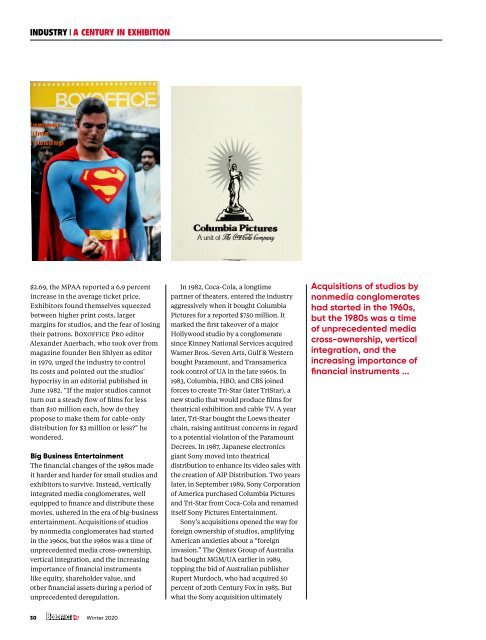Boxoffice Pro - Winter 2020
Boxoffice Pro is the official publication of the National Association of Theatre Owners
Boxoffice Pro is the official publication of the National Association of Theatre Owners
You also want an ePaper? Increase the reach of your titles
YUMPU automatically turns print PDFs into web optimized ePapers that Google loves.
INDUSTRY A CENTURY IN EXHIBITION<br />
$2.69, the MPAA reported a 6.9 percent<br />
increase in the average ticket price.<br />
Exhibitors found themselves squeezed<br />
between higher print costs, larger<br />
margins for studios, and the fear of losing<br />
their patrons. <strong>Boxoffice</strong> <strong>Pro</strong> editor<br />
Alexander Auerbach, who took over from<br />
magazine founder Ben Shlyen as editor<br />
in 1979, urged the industry to control<br />
its costs and pointed out the studios’<br />
hypocrisy in an editorial published in<br />
June 1982. “If the major studios cannot<br />
turn out a steady flow of films for less<br />
than $10 million each, how do they<br />
propose to make them for cable-only<br />
distribution for $3 million or less?” he<br />
wondered.<br />
Big Business Entertainment<br />
The financial changes of the 1980s made<br />
it harder and harder for small studios and<br />
exhibitors to survive. Instead, vertically<br />
integrated media conglomerates, well<br />
equipped to finance and distribute these<br />
movies, ushered in the era of big-business<br />
entertainment. Acquisitions of studios<br />
by nonmedia conglomerates had started<br />
in the 1960s, but the 1980s was a time of<br />
unprecedented media cross-ownership,<br />
vertical integration, and the increasing<br />
importance of financial instruments<br />
like equity, shareholder value, and<br />
other financial assets during a period of<br />
unprecedented deregulation.<br />
In 1982, Coca-Cola, a longtime<br />
partner of theaters, entered the industry<br />
aggressively when it bought Columbia<br />
Pictures for a reported $750 million. It<br />
marked the first takeover of a major<br />
Hollywood studio by a conglomerate<br />
since Kinney National Services acquired<br />
Warner Bros.-Seven Arts, Gulf & Western<br />
bought Paramount, and Transamerica<br />
took control of UA in the late 1960s. In<br />
1983, Columbia, HBO, and CBS joined<br />
forces to create Tri-Star (later TriStar), a<br />
new studio that would produce films for<br />
theatrical exhibition and cable TV. A year<br />
later, Tri-Star bought the Loews theater<br />
chain, raising antitrust concerns in regard<br />
to a potential violation of the Paramount<br />
Decrees. In 1987, Japanese electronics<br />
giant Sony moved into theatrical<br />
distribution to enhance its video sales with<br />
the creation of AIP Distribution. Two years<br />
later, in September 1989, Sony Corporation<br />
of America purchased Columbia Pictures<br />
and Tri-Star from Coca-Cola and renamed<br />
itself Sony Pictures Entertainment.<br />
Sony’s acquisitions opened the way for<br />
foreign ownership of studios, amplifying<br />
American anxieties about a “foreign<br />
invasion.” The Qintex Group of Australia<br />
had bought MGM/UA earlier in 1989,<br />
topping the bid of Australian publisher<br />
Rupert Murdoch, who had acquired 50<br />
percent of 20th Century Fox in 1985. But<br />
what the Sony acquisition ultimately<br />
Acquisitions of studios by<br />
nonmedia conglomerates<br />
had started in the 1960s,<br />
but the 1980s was a time<br />
of unprecedented media<br />
cross-ownership, vertical<br />
integration, and the<br />
increasing importance of<br />
financial instruments ...<br />
30 <strong>Winter</strong> <strong>2020</strong>

















